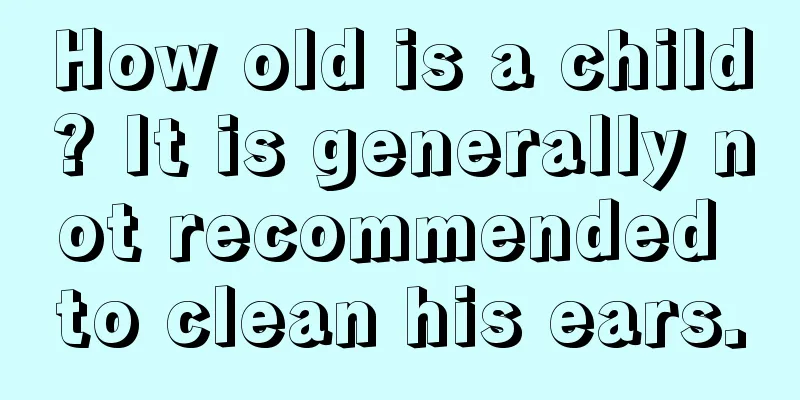Perfect tutorial to help your baby sleep well

|
Sleeping can change a person's appearance, do you believe it? Women can beautify their skin by sleeping more, so babies can also become more beautiful if they adopt the correct sleeping posture~ Let your baby sleep with a good "appearance" perfect tutorial, give you a beautiful baby~ Perfect tutorial to help your baby sleep wellWhether a baby is good-looking or not, in addition to being inherited and determined by God, can also be "optimized" or "remedied" through acquired conditioning and care, such as diet and care. In addition, a baby's "good looks" can also be achieved through sleep. Tutorial 1: Let your baby sleep well When a baby is born, the skull is still soft and has not yet fully ossified. There is still room for growth between the bone fragments, so the baby's head shape is plastic. In addition, the baby's neck muscles are not yet strong enough to turn the heavy head. When a bone fragment in a certain position bears the pressure of the entire head weight for a long time, it will affect the development of the head shape. As the baby grows, the hardness of the skull gradually increases, the bone sutures close together, and the head shape is difficult to change. The golden period for adjusting the baby's head shape is within two months after the baby is born. If you find that your baby's head shape is asymmetrical or ugly after two months, it is still in time to adjust it in the third month. The head shape of babies over three months old is basically fixed. When the baby is one to one and a half years old, the fontanelle will close and the head shape will be fixed. It will be difficult to change it. Tutorial 2: Let your baby sleep with a good face shape Chinese parents are accustomed to letting their babies sleep on their backs, so Chinese faces are generally flat and lack a strong three-dimensional sense. Westerners, on the other hand, are accustomed to letting their babies sleep on their stomachs, which causes long-term pressure on both sides of the cheeks, making the face shape more distinct. Parents can adjust the baby's sleeping position according to the baby's appearance. Some babies have high cheekbones. If they often sleep on their stomachs, their cheekbones will be higher and their face shape will not look good. It is recommended that such babies sleep on their left or right sides, which will not cause a flat skull, and the forehead and occipital bone will not be squeezed, so they can sleep with a better face shape. Some babies have low cheekbones and their parents have relatively flat faces. If they sleep on their stomachs, their cheekbones will protrude slightly, increasing the three-dimensional sense of the face, but this will also make the baby's face narrower and longer. Therefore, this sleeping position is more suitable for babies with low cheekbones and round faces. However, prone sleeping position (i.e. sleeping on one's stomach) also has certain risks. You must always pay attention to whether the baby's airway is unobstructed to prevent airway obstruction. Therefore, someone must be on duty to take care of the baby. Tutorial 3: Let your baby sleep with delicate facial features Sleeping on one side for a long time may cause the baby's left and right face to be asymmetrical. Therefore, the baby's sleeping position should be adjusted at any time. Sleeping on the prone position can compress the cheekbones and prevent them from overdeveloping, so that the nose bridge is high and the side lines of the mouth and chin are straight; sleeping on the back can make the baby's facial features more regular and symmetrical, and the face is delicate. Tutorial 4: Let your baby sleep to get good skin Sleeping on your back can help you get good skin, because lying on your back allows your facial muscles to relax optimally, blood circulation is not disturbed, and your facial skin is fully supplied with oxygen and nutrients. Tutorial 5: Let your baby sleep with a "small face" We often say "small face beauty", which shows that "small face" is a prerequisite for "beauty". If the baby is allowed to sleep on his side, it can prevent the mandible from overdeveloping and the cheeks from becoming too big to form a big cheek face. When sleeping on your side, you should alternate between the two sides and not stay on one side to avoid asymmetry in the shape of your head and face. Also, be careful not to deform the earlobe. Tutorial 6: Keep your baby away from cross-eye contact If the baby is always allowed to sleep on his back, his eyes will be looking at the limited space above for a long time, which may cause cross-eyes. Therefore, parents are advised not to let the baby sleep on his back for a long time, and not to hang toys above the baby's bed to prevent cross-eyes. Tutorial 7: Keep your baby away from "protruding ears" When the baby lies on his side, the mother must first smooth the baby's ears back. Because the ears of newborn babies are very soft, even if they are pressed, the baby will not feel pain, so he will not cry. Mothers should know that this can prevent the baby from having ugly "protruding ears". What is the best sleeping position for newborns?What is the best sleeping posture for a newborn? Under normal circumstances, most newborns sleep on their backs. However, if a newborn is accustomed to sleeping on his back, the back of the baby's head will become flat and the forehead will appear wide over time, which will greatly affect the proportion and beauty of the facial features. Which sleeping position is best for newborns? It is best for newborn babies to sleep in the side-lying position. This sleeping position can not only limit the excessive development of the baby's mandible and prevent the two sides of the face from being too large, but also prevent the back of the head and forehead from being squeezed. It should be noted that mothers should often help their babies to switch positions when sleeping, to avoid the baby sleeping on one side for too long, which will cause the head to tilt. In fact, it is not difficult for babies to have a symmetrical and beautiful head shape when sleeping. However, if the baby is born with a relatively large front-to-back diameter of the skull, a small face, and facial features that are close together, the side-lying position is not suitable. The medical community has not yet given a single standard answer to the question of which sleeping position is best for newborns. Babies can choose their own sleeping position and do not have to stick to a certain one. You can decide based on the preferences of parents and the habits or special needs of the baby. But please remember that when the baby is sleeping, adults need to check on him at all times to ensure his safety. Health signs of abnormal sleeping posture in newbornsUnder normal circumstances, babies should be quiet and comfortable when sleeping, with a little sweat on their heads and even and silent breathing. However, when babies are sick, parents can initially understand their health problems from abnormal sleeping positions, such as irritability, crying, easy awakening, dry body after falling asleep, flushed face, rough and rapid breathing, and fast pulse. Therefore, parents should carefully observe the sleeping position of newborns, understand the baby's physical information in time, and prevent the occurrence of diseases. 1. After falling asleep, the baby lifts his clothes and kicks the quilt, and his cheekbones and lips are red, he is thirsty, likes cold drinks or drinks a lot of water, and some have fever in the palms and soles. Signal: This is caused by yin deficiency and lung heat, indicating that the baby is probably suffering from respiratory diseases, such as colds, pneumonia, tuberculosis, etc. Parents should take their children to the hospital for diagnosis and treatment as soon as possible, and take medicine under the guidance of the doctor for prevention and treatment. 2. The baby falls asleep with his back facing downwards, buttocks raised high, accompanied by oral ulcers, irritability, panic and other symptoms. Signal: This is caused by "heart meridian heat". It is often caused by residual heat after the child has suffered from various acute fevers, indicating that the baby's condition has not yet recovered and needs to be treated to prevent recurrence. 3. After falling asleep, the baby tosses and turns, often accompanied by bad breath, shortness of breath, abdominal distension, dry mouth, red lips, thick yellow tongue coating, dry stool and other symptoms. Signal: This is because there is food residue in the stomach. Parents should take the baby to see a pediatrician. The current dietary structure makes the proportion of babies suffering from adult diseases higher and higher, so be careful to prevent the baby from suffering from gastrointestinal diseases such as gastritis and gastric ulcer. 4. The baby keeps crying during sleep, often shakes his head, scratches his ears with his hands, and sometimes has a fever. Signal: This may be a reminder to parents that the baby has otitis externa, eczema, or otitis media, and the baby should be taken to see an otologist immediately. 5. After the baby falls asleep, his limbs shake as if he is startled. Signal: The baby can recall whether he is too tired or mentally stimulated during the day. If not, then you should pay attention, because the baby may have sleep disorders or neurological diseases. 6. The baby scratches his buttocks with his hands after falling asleep. Signal: Parents should carefully check. If you can see small white thread-like worms crawling around the baby's anus, it may be pinworm disease. This is a common disease in babies, so you should take your baby to the hospital for treatment. 7. When the baby is sleeping, especially when sleeping on his back, he snores and breathes with his mouth open. Signal: This is because the child's adenoma and tonsils are enlarged and affect breathing. Parents need to take the baby to the hospital for a detailed examination. If necessary, the tonsils can be removed surgically. 8. The baby's sleeping position changes, such as hunching over or covering the abdomen with both hands, and has diarrhea, vomiting and other symptoms. Signal: The baby may have enteritis or even dysentery. See a doctor in time. |
Recommend
What is a pregnancy test stick? What are the brands of pregnancy test sticks?
There are many ways to test pregnancy now, which ...
What should I do if my child often catches a cold? How can I improve my child's immunity?
Does your child often get sick? Don't worry, ...
How to wean? Scientific and reasonable weaning methods and precautions
Many babies need to prepare for weaning when they...
When is the best time to sleep in a separate bed from your child? Should babies sleep in separate rooms or beds from their parents?
Many people say that it is best for newborn babie...
What should the weaning process be like? What issues should be paid attention to during the weaning process?
Many babies will be weaned at a certain time. So,...
What should I pay attention to when preparing for pregnancy? What are the precautions before pregnancy?
In order to give birth to a healthy and smart bab...
How to change diapers How to use diapers
Diapers are a must-have for babies, but many pare...
How to calculate the due date of IVF? The harm of IVF to women
For couples who have difficulty conceiving, IVF i...
What is the cause of weak uterine contractions? What should I do if I have weak uterine contractions?
When a pregnant woman gives birth, her uterus wil...
Who can't eat bacon? Who can't eat bacon?
Although bacon is delicious, it is not suitable f...
What are the typical symptoms of gastritis in children? How to treat gastritis in children?
Gastritis is a common disease among children nowa...
Can I wear makeup during pregnancy? Can I use skin care products during pregnancy?
It is the nature of every girl to love beauty, bu...
Can an 8-month-old baby eat crab porridge? Can an 8-month-old baby eat crab?
Now is the season for eating crabs. Many parents ...
How to treat summer heat syndrome in children? What to do if your baby has summer heat syndrome?
How to treat children's summer heat syndrome?...
Can I use a fan during confinement in summer? Can fans be used by mothers in summer?
The most important issue for mothers who are conf...









